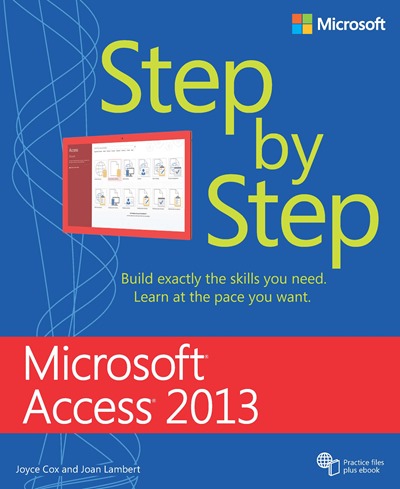RTM’d today: Microsoft Access 2013 Step by Step
 We are excited to announce that Microsoft Access 2013 Step by Step (ISBN 9780735669086) by Joan Lambert and Joyce Cox has shipped to the printer!
We are excited to announce that Microsoft Access 2013 Step by Step (ISBN 9780735669086) by Joan Lambert and Joyce Cox has shipped to the printer!
Preorder
| From Amazon.com | click here |
| From The Microsoft Press Store | |
| From an independent bookseller | click here |
Download Free Sample Chapters
| From the Microsoft.com Download Center | click here |
The smart way to learn Microsoft Access 2013 —one step at a time!
Experience learning made easy—and quickly teach yourself how to create your own database with Microsoft Access 2013.
With Step by Step, you set the pace—building and practicing the skills you need, just when you need them!
• Build a custom database from scratch or templates
• Create forms to enter, edit, and display data
• Write queries to extract and manipulate data
• Import data from other databases and documents
• Design, run, and print reports, and add subreports
• Help prevent data corruption and unauthorized access
Your Step by Step digital content includes:
• All the book’s practice files
• Fully searchable ebook
Introduction (excerpt)
Over the years, Microsoft has put a lot of effort into making Access not only one of the
most powerful consumer database programs available, but also one of the easiest to learn
and use. Because Access is part of Microsoft Office 2013, you can use many of the techniques
you use with Microsoft Word and Microsoft Excel. For example, you can use familiar
commands, buttons, and keyboard shortcuts to open and edit the information in Access
tables. And you can easily share information between Access and Word, Excel, or other
Office programs. Microsoft Access 2013 Step by Step offers a comprehensive look at the
features of Access that most people will use most frequently.
Who this book is for
Microsoft Access 2013 Step by Step and other books in the Step by Step series are designed
for beginning-level to intermediate-level computer users. If part of your job involves entering
data in or producing reports from a database designed by someone else, this book
will help you understand the behind-the-scenes functionality of the database. If you are
tasked with the maintenance of an existing database, you will learn important techniques
for ensuring data integrity. Although we don’t cover the macro and VBA functionality that
enables experienced developers to create full-featured database applications, we do touch
on more advanced topics such as controlling access and preventing problems.
Examples shown in the book generally pertain to small and medium businesses but teach
skills that can be used in organizations of any size. The databases you create and work with
are desktop databases, designed to be used in Access 2013 on a local computer. Access
2013 has powerful new capabilities to enable more advanced users to create applications,
called Access web apps, that are stored as SQL databases on a Microsoft SharePoint 2013
site and can be viewed and manipulated through a web browser. Because of the behind-the-
scenes requirements of these databases, we briefly describe them but don’t cover them
in depth.
Whether you are already comfortable working in Access and want to learn about new features
in Access 2013 or are new to Access, this book provides invaluable hands-on experience
so that you can confidently create and work with many types of desktop databases.
How this book is organized
This book is divided into three parts. Part 1 explains how to get data into a database, either
directly by entering it into tables or indirectly by using forms; and how to get information
out of a database, either by displaying it on the screen or by printing it in reports. Part 2
discusses ways to ensure that the data in related tables is accurate, how to use queries
to extract data from related tables, and how to create forms and reports that use related
tables.
Part 3 covers more advanced Access techniques, including securing the database
and customizing the program to fit the way you work. With this three-part structure, readers
who are new to the program can acquire basic skills and then build on them, whereas
readers who are comfortable with Access 2013 basics can focus on material that is of the
most interest to them.
Chapter 1 contains introductory information that will primarily be of interest to readers
who are new to Access or are upgrading from Access 2003 or an earlier version. If you have
worked with a more recent version of Access, you might want to skip directly to Chapter 2.
This book has been designed to lead you step by step through all the tasks a beginning-level
or intermediate-level user is most likely to want to perform with Access 2013. If you
start at the beginning and work your way through all the exercises, you will gain enough
proficiency to be able to create simple databases and work with more complex databases
created by experts. However, each chapter is self-contained, so you can jump in anywhere
to acquire exactly the skills you need.
Contents at a glance
Introduction
Part 1 Simple database techniques
1 Explore Microsoft Access 2013
2 Create databases and simple tables
3 Create simple forms
4 Display data
5 Create simple reports
Part 2 Relational database techniques
6 Maintain data integrity
7 Create queries
8 Create custom forms
9 Create custom reports
Part 3 Database management and security
10 Import and export data
11 Make databases user friendly
12 Protect databases
13 Work in Access more efficiently
Glossary Keyboard shortcuts Index